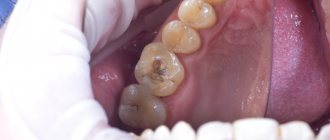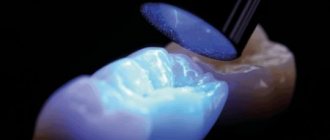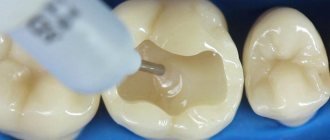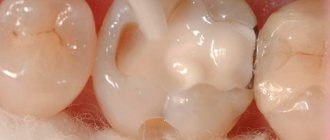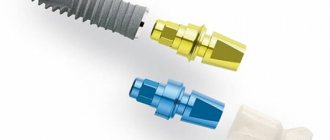Statistics from dental practice confirm the fact that light fillings are most often used and are gradually replacing other filling materials. This happens due to the objective advantages and high performance of fillings in practice.
Specialists from the network of dental clinics "LeaderStom" use light fillings of the latest developments and recommend this material for the restoration of crowns and the elimination of caries. If you notice the first signs of tooth decay and plan to eliminate it in a timely manner, then the LeaderStom clinic will be able to provide you with exactly the quality that meets the most progressive standards of dentistry.
Ceramic filling CEREC with a 50% discount
Heliocomposite composition
To understand how a light filling differs from a regular one, you need to know its composition and principle of operation. Light-curing fillings consist of a polymer matrix, glass-ceramic filler and bonding material. The principle of polymerization is a substance that breaks down into free radicals under the influence of ultraviolet rays. These radicals are responsible for the hardening of the material. The quality of stability and strength of the material depends on the size of the particles in the filler.
They can be: • mini-filled; • macro-, micro-filled; • nanohybrid.
The choice of material composition is determined by the dentist, based on hardness parameters or decorative priority.
The light filling performs the function of protecting tooth tissue from mechanical and chemical irritants. It prevents pathogenic microbes from entering the tooth and withstands significant daily loads. Therefore, the requirements for the quality of filling material are very high, and the light filling fully lives up to the expectations placed on it.
How much does a light seal cost?
Prices for dental work in reliable clinics are based on how complicated (or neglected) the tooth is. The cost of a light filling also depends on the condition of the tooth - the depth of the carious cavity, the degree of destruction of the walls, and the health of the canals. The more work the dentist requires, the higher the price will be. But the financial side of the issue may depend not only on the illness that the patient brought with him. If the clinic has a high status and brilliant authority, the price for a light filling may be too high. This is how reputable clinics maintain their status. Conversely, if a dental office has opened recently, and its main task is to attract customers, the price tags for services may be low.
In general, the cost of a light-curing filling ranges from 2,000 to 15,000 rubles. But higher prices are also possible (as a rule, in cases where the tooth is too neglected). Filling the front teeth is always more expensive than the back teeth, because the smile area requires the highest quality and most expensive materials. The variety of dental clinics today is too great to not know where to go. Each patient decides for himself what to choose: either too expensive treatment, but with a guarantee of quality, or hope for a successful result and significant savings. There is a third option: price and quality in equal proportions - you need to choose this one. As a rule, many patients rely on reviews from friends and acquaintances, and on this basis they choose a clinic and a dentist. The most important thing is not to forget that a healthy smile is priceless.
Durability
The average lifespan of light seals is about five years. However, in practice, they can keep the tooth intact for much longer. For greater durability of the filling, dentists at the LeaderStom clinic recommend carefully monitoring oral hygiene, proper nutrition and sufficient calcium intake into the body.
Stable fastening of the light filling is achieved through an adhesive system - a special light-sensitive liquid that is used to treat the tooth walls. Performing the function of “glue”, it so firmly connects the photopolymer material with the tooth enamel that subsequently a chemical calcium exchange begins to occur between these tissues.
What manufacturers' fillings do we use?
- Charisma is a German material with the smallest particle size, a high degree of adherence and a smooth surface.
- Filtek is a composite of the American company 3M ESPE, has high strength, 35 shades, and is close in physical properties to tooth tissue.
- Estelite is a Japanese material, resistant to staining, bacteria, abrasion like natural teeth.
- Esthet-X is a composite from the DENTSPLY brand (USA/Switzerland), suitable for any restoration, characterized by resistance to chipping and durability.
Making an appointment does not oblige you to anything, you can cancel your appointment at any time
Make an appointment
Biological compatibility
It is known that filling material such as amalgam, which was used several years ago for dental treatment, contains mercury in its composition. Another material, glass ionomer cement, is also used in dentistry, but contains fluoride, which recent research suggests may be harmful to the pineal gland. In this range of filling materials, light fillings are distinguished by their maximum biological compatibility. They do not emit toxic substances, do not destroy the tooth crown (as cement composites do due to higher hardness than the tooth), and have optimal expansion-compression characteristics under temperature changes.
What material is used
It is a light-curing composite that hardens when exposed to ultraviolet light. As a result of using this material, it turns out that the installed filling is light. In its original form, it is plastic, so the doctor can accurately copy the anatomical shape of the tooth, restoring its missing part. The composition includes heliocomposite, glass ceramics, stabilizers, and pigments that give a certain shade.
Advantages:
- Absolute safety and hypoallergenic.
- Non-toxic
- Withstands significant chewing load.
- Excellent polishability.
- They have the natural shine of healthy tooth enamel.
- Suitable for all patients.
Certain types of composite materials (for example, LuxaCore) contain zirconium dioxide, so we use them to fix intra-canal pins, which allow us to restore severely damaged teeth.
High aesthetic characteristics
The aesthetic factor is especially important when eliminating caries on the front teeth. The material of the photo light seal lends itself perfectly to final processing: grinding and polishing. And the color set provided by raw material manufacturers includes the full range of possible shades of tooth enamel. This fact allows you to accurately imitate the natural color of the tooth in the absence of boundaries between the enamel tissue and the filling. Even after several years of use, it can be quite difficult to determine this boundary, and immediately after tooth restoration it is simply impossible.
The effect of preserving tooth color gradations is possible thanks to the use of the latest layer-by-layer application technologies. The so-called polychrome filling uses more than two color components: darker at the base of the tooth and lighter towards the cusps. The most modern compositions of filling materials used in the LeaderStorm clinic were developed using nanotechnology. They allow you to achieve maximum aesthetic effect when restoring a tooth.
There are rare exceptions when priority is given to chemical composites. For example, when installing the material in a place that is difficult to reach for ultraviolet radiation. If a tooth restoration is carried out with a light filling, then the light polymerization will not be effective and the composite will not harden properly. In such situations, a chemically cured material is recommended.
All of the above advantages of light seals, reviews are very positive, which is confirmed in practice.
Tooth filling using light heliocomposites
06/04/2019 The filling can be either simple cement or made from high-tech materials called heliocomposites. The following names for these materials are common in everyday life: “helium filling”, “light filling”, “light-curing filling”, “reflective filling”, etc. The essence of this material is in the title:
- Helio - from the Greek word helios, i.e. sun, light
- A composite is a material that contains many particles that perform their specific function.
Heliocomposite is a modern material that we use every day, having long ago abandoned cement fillings, which have neither aesthetics nor strength and can only be used as a temporary filling.
Restoring a carious tooth with heliocomposite is the main method of caries treatment. Under anesthesia, the dentist carefully removes all carious tissue down to healthy dentin and carries out antiseptic treatment of the cavity. Further, if necessary, if the cavity is deep and borders the nerve, the doctor will apply a pad made of a special material to protect the nerve itself. Then the material itself is applied layer by layer into the cavity, with each layer illuminated by a special lamp, which makes it harden. Thus, we get a tooth cured of caries and restored with heliocomposite, which will serve for a long time and not bother you, because heliocomposite itself has many advantages, such as:
- Strength. Withstands chewing loads and does not crumble unlike cement
- Aesthetics. Available in a variety of customizable colors
- Tightness. The formation of secondary caries under the filling is minimized, since microorganisms cannot penetrate under it. Heliocomposite is similar in its physical properties to tooth tissue, has comparable strength, elasticity, and color.
In terms of stages and materials, restoration of a carious tooth with heliocomposite is similar to restoration with composite material. But only during restoration does the doctor use other methods of applying the material and shaping its anatomical and color features, which is labor-intensive. We also use a material that has an expanded range of colors and nanoparticles in its composition, which give a natural shine to the restoration itself.
I would especially like to note that all stages of restoring a carious tooth with heliocomposite in our World of Smiles dentistry are included in the cost of caries treatment. You receive anesthesia and possible therapeutic pads absolutely free.
Features of conventional fillings, advantages and disadvantages
The phrase “conventional filling” refers to chemically cured filling material. The process of making such a filling involves mixing the filling composition. When the components of a conventional filling are mixed, a chemical reaction occurs, as a result of which the filling material becomes hard over a period of time. Chemical fillings not only help to seal a tooth affected by caries, in addition to performing the filling function, chemical fillings protect the tooth from the recurrence of the carious process, this happens due to fluoride, which is released by the chemical filling during the time it is worn. The advantages of conventional fillings also include the fact that their hardness is identical to the hardness of tooth enamel.
Conventional fillings differ from each other in the chemical components they contain. Chemical fillings may contain glass ionomer cement or a composite, which is a mixture of various compositions.
Advantages of composite fillings:
- composite fillings are not exposed to liquid agents, including saliva;
- Composite fillings have the highest degree of strength.
Advantages of glass ionomer cement fillings:
- glass ionomer cement fillings contain fluoride compounds;
- glass ionomer fillings fit most tightly to the surface of the teeth and have minimal chances of “peeling off”;
- Their glass ionomer cement fillings make it possible to fill molars with the highest quality.
Caries of baby teeth
The appearance of caries greatly complicates the life of the baby and his parents.
Baby teeth are prone to rapid destruction and literally in 2-3 weeks an inconspicuous white dot on the enamel turns into a full-fledged carious cavity. If the tooth is not treated, then in the future it will lead to the development of pulpitis, periodontitis, and loss of a baby tooth. Filling has been and remains the most effective method of combating caries. The pediatric dentist will examine the child’s oral cavity, assess the extent of the damage, and select the appropriate filling material. And there is one undeniable advantage of paid treatment. State clinics are limited by VHI requirements for the selection of compositions, but in Aza&Buka pediatric dentistry they use really good and durable material.
When choosing a filling material, the pediatric dentist takes into account several factors:
- the age of the patient and his ability to withstand prolonged treatment;
- neglect of the carious process;
- characteristics of the child’s physical and emotional state.
